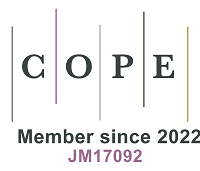REFERENCES
1. Chou, W. C.; Gaynor, J. W.; Graham, E. M.; et al. A machine learning-based clustering analysis to explore bisphenol A and phthalate exposure from medical devices in infants with congenital heart defects. Environ. Health. Perspect. 2025, 133, 67016.
2. Costa, H. E.; Cairrao, E. Effect of bisphenol A on the neurological system: a review update. Arch. Toxicol. 2024, 98, 1-73.
3. Li, B.; Zhao, X.; Ding, Y.; Zhang, Y. Network toxicology and molecular docking to investigate the mechanism of bisphenol A toxicity in human diabetic cardiomyopathy. Ecotoxicol. Environ. Saf. 2025, 299, 118301.
4. Liu, J.; Martin, J. W. Prolonged exposure to bisphenol A from single dermal contact events. Environ. Sci. Technol. 2017, 51, 9940-9.
5. Braun, J. M. Early-life exposure to EDCs: role in childhood obesity and neurodevelopment. Nat. Rev. Endocrinol. 2017, 13, 161-73.
6. Fang, H.; Tong, W.; Branham, W. S.; et al. Study of 202 natural, synthetic, and environmental chemicals for binding to the androgen receptor. Chem. Res. Toxicol. 2003, 16, 1338-58.
7. Rochester, J. R. Bisphenol A and human health: a review of the literature. Reprod. Toxicol. 2013, 42, 132-55.
8. Moriyama, K.; Tagami, T.; Akamizu, T.; et al. Thyroid hormone action is disrupted by bisphenol A as an antagonist. J. Clin. Endocrinol. Metab. 2002, 87, 5185-90.
9. National Standard of the People’s Republic of China. GB 38995-2020. Infant and toddler bottles and pacifiers. 2020. https://openstd.samr.gov.cn/bzgk/gb/newGbInfo?hcno=39161D96403B68B05A675DBCA1564254. (accessed 23 Sep 2025).
10. National Standard of the People’s Republic of China. GB 4806.6-2016. National Food Safety Standard - plastic resin for food contact. 2016. http://www.foods-test.com/GB4806.6-2016-kw.pdf. (accessed 23 Sep 2025).
11. Mhaouty-Kodja, S.; Zalko, D.; Tait, S.; et al. A critical review to identify data gaps and improve risk assessment of bisphenol A alternatives for human health. Crit. Rev. Toxicol. 2024, 54, 696-753.
12. van den Brand, A. D.; Hessel, E. V. S.; Rijk, R.; et al. A prioritization strategy for functional alternatives to bisphenol A in food contact materials. Crit. Rev. Toxicol. 2024, 54, 291-314.
13. European Union. Commission Directive 2011/8/EU of 28 January 2011 amending Directive 2002/72/EC as regards the restriction of use of Bisphenol A in plastic infant feeding bottles Text with EEA relevance. 2011. http://data.europa.eu/eli/dir/2011/8/oj. (accessed 23 Sep 2025).
14. European Union. Commission Regulation (EU) 2024/3190 of 19 December 2024 on the use of bisphenol A (BPA) and other bisphenols and bisphenol derivatives with harmonised classification for specific hazardous properties in certain materials and articles intended to come into contact with food, amending Regulation (EU) No 10/2011 and repealing Regulation (EU) 2018/213. 2024. http://data.europa.eu/eli/reg/2024/3190/oj. (accessed 23 Sep 2025).
15. Zhou, J.; Chen, X. H.; Zhang, D. D.; Jin, M. C.; Zhuang, L.; Du, Y. Determination of multiple bisphenol analogues and their metabolites in human serum by liquid chromatography tandem mass spectrometry. Environ. Pollut. 2022, 312, 120092.
16. Pivnenko, K.; Laner, D.; Astrup, T. F. Dynamics of bisphenol A (BPA) and bisphenol S (BPS) in the European paper cycle: need for concern? Resour. Conserv. Recycl. 2018, 133, 278-87.
17. Lehmler, H. J.; Liu, B.; Gadogbe, M.; Bao, W. Exposure to bisphenol A, bisphenol F, and bisphenol S in U.S. adults and children: the national health and nutrition examination survey 2013-2014. ACS. Omega. 2018, 3, 6523-32.
19. ECHA. REACH - Registration, Evaluation, Authorisation and Restriction of Chemicals Regulation. 2023. https://echa.europa.eu/information-on-chemicals/registered-substances. (accessed 23 Sep 2025).
20. Catenza, C. J.; Farooq, A.; Shubear, N. S.; Donkor, K. K. A targeted review on fate, occurrence, risk and health implications of bisphenol analogues. Chemosphere 2021, 268, 129273.
21. Wu, L. H.; Zhang, X. M.; Wang, F.; et al. Occurrence of bisphenol S in the environment and implications for human exposure: a short review. Sci. Total. Environ. 2018, 615, 87-98.
22. Huang, S.; Wang, D.; Qi, Z.; Long, C.; Li, G.; Yu, Y. A large-scale nationwide study of urinary phenols in the Chinese population. Sci. Total. Environ. 2023, 894, 164850.
23. Tang, S.; He, C.; Thai, P. K.; et al. Urinary concentrations of bisphenols in the Australian population and their association with the per capita mass loads in wastewater. Environ. Sci. Technol. 2020, 54, 10141-8.
24. Ye, X.; Wong, L. Y.; Kramer, J.; Zhou, X.; Jia, T.; Calafat, A. M. Urinary concentrations of bisphenol A and three other bisphenols in convenience samples of U.S. adults during 2000-2014. Environ. Sci. Technol. 2015, 49, 11834-9.
25. Gyllenhammar, I.; Glynn, A.; Jönsson, B. A.; et al. Diverging temporal trends of human exposure to bisphenols and plastizisers, such as phthalates, caused by substitution of legacy EDCs? Environ. Res. 2017, 153, 48-54.
26. Cao, J.; Ma, W.; Gao, Y.; Long, C.; Yu, Y. Derivation of the oral reference dose (RfD) for bisphenol S and bisphenol F based on epidemiological and experimental studies. Ecotoxicol. Environ. Saf. 2025, 293, 118045.
27. United States Environmental Protection Agency. Integrated Risk Information System (IRIS), Chemical Assessment Summary. Reference dose for oral exposure (RfD) (Bisphenol A; CASRN 80-05-7). 1988. https://iris.epa.gov/static/pdfs/0356_summary.pdf. (accessed 23 Sep 2025).
28. EFSA Panel on Food Contact Materials, Enzymes, Flavourings and Processing Aids (CEF). Scientific opinion on the risks to public health related to the presence of bisphenol A (BPA) in foodstuffs. Part II - toxicological assessment and risk characterization. EFSA. J. 2015, 13, 3978.
29. EFSA Panel on Food Contact Materials, Enzymes and Processing Aids (CEP); Lambré C, Barat Baviera JM, Bolognesi C, et al. Re-evaluation of the risks to public health related to the presence of bisphenol A (BPA) in foodstuffs. EFSA. J. 2023, 21, e06857.
30. Lee, S.; Liu, X.; Takeda, S.; Choi, K. Genotoxic potentials and related mechanisms of bisphenol A and other bisphenol compounds: a comparison study employing chicken DT40 cells. Chemosphere 2013, 93, 434-40.
31. Abdulla, A.; Yan, H.; Chen, S.; et al. A multichannel microfluidic device for revealing the neurotoxic effects of Bisphenol S on cerebral organoids under low-dose constant exposure. Biosens. Bioelectron. 2025, 267, 116754.
32. Zhang, Q.; Li, M.; Wang, P.; Lin, X.; Lai, K. P.; Ding, Z. Integrated analysis reveals the immunotoxicity mechanism of BPs on human lymphocytes. Chem. Biol. Interact. 2024, 399, 111148.
33. Zhang, X.; Zhang, X.; Zhang, Z.; et al. Bisphenol S causes excessive estrogen synthesis by activating FSHR and the downstream cAMP/PKA signaling pathway. Commun. Biol. 2024, 7, 844.
34. Hassan, A. A.; Abdelgayed, S. S.; Mansour, S. Z. Liver and ovarian toxicities boosted by bisphenol and gamma radiation in female albino rats. Hum. Exp. Toxicol. 2024, 43, 9603271231219264.
35. Liu, J.; Yu, L.; Castro, L.; et al. Induction of fibrosis following exposure to bisphenol A and its analogues in 3D human uterine leiomyoma cultures. J. Hazard. Mater. 2024, 476, 134772.
36. Chouchene, L.; Boughammoura, S.; Ben Rhouma, M.; et al. Effect of thyroid disruption on ovarian development following maternal exposure to Bisphenol S. Environ. Sci. Pollut. Res. Int. 2024, 31, 52596-614.
37. Sudhakaran, G.; Kesavan, D.; Ranjan Nayak, S. P. R.; et al. Bisphenol A-induced ovarian damage countered by luteolin: experiments in in vitro CHO cells and in vivo PCOS phenotype zebrafish. Tissue. Cell. 2024, 91, 102532.
38. Guo, C.; Lv, L.; Chen, X.; et al. Low-dose bisphenol AF exerts slight effects on glycolipid metabolism but causes metabolic disorders under the stress of Western diet in mice. Environ. Pollut. 2025, 369, 125861.
39. Hasan, A. K. M. M.; Martyniuk, C. J.; Niyogi, S.; Chivers, D. P. A comprehensive review on the neurobehavioural effects of bisphenol compounds and the underlying molecular mechanisms in zebrafish (Danio rerio). Comp. Biochem. Physiol. C. Toxicol. Pharmacol. 2025, 296, 110228.
40. Alharbi, H. F.; Algonaiman, R.; Alduwayghiri, R.; et al. Exposure to bisphenol A substitutes, bisphenol S and bisphenol F, and its association with developing obesity and diabetes mellitus: a narrative review. Int. J. Environ. Res. Public. Health. 2022, 19, 15918.
41. Su, X.; Kai, L.; Han, X.; et al. Equipotent bisphenol S and bisphenol F with widely differing modes of action exhibit additive effects in immunotoxicity: insights based on intrinsic immunity, apoptosis and regeneration, and oxidative stress. Sci. Total. Environ. 2025, 977, 179405.
42. Wang, J.; Niu, G.; Mai, H.; et al. The protective role of 3-Indoleglyoxylic acid in bisphenol S-induced intestinal barrier dysfunction via mitochondrial ROS-Mediated IL-17/CXCL10/TNF-α signaling. Environ. Int. 2025, 199, 109477.
43. Gao, Z.; Liu, S.; Tan, L.; et al. Testicular toxicity of bisphenol compounds: homeostasis disruption of cholesterol/testosterone via PPARα activation. Sci. Total. Environ. 2022, 836, 155628.
44. Duan, Y.; Yao, Y.; Wang, B.; et al. Association of urinary concentrations of bisphenols with type 2 diabetes mellitus: a case-control study. Environ. Pollut. 2018, 243, 1719-26.
45. Ghayda, R. A.; Williams, P. L.; Chavarro, J. E.; et al. Urinary bisphenol S concentrations: potential predictors of and associations with semen quality parameters among men attending a fertility center. Environ. Int. 2019, 131, 105050.
46. Chen, P. P.; Liu, C.; Zhang, M.; et al. Associations between urinary bisphenol A and its analogues and semen quality: a cross-sectional study among Chinese men from an infertility clinic. Environ. Int. 2022, 161, 107132.
47. Jiang, Y.; Li, J.; Xu, S.; et al. Prenatal exposure to bisphenol A and its alternatives and child neurodevelopment at 2 years. J. Hazard. Mater. 2020, 388, 121774.
48. Geiger, S. D.; Musaad, S.; Hill, J.; Aguiar, A.; Schantz, S. Sex-specific associations between urinary bisphenols concentrations during pregnancy and problematic child behaviors at age 2 years. Neurotoxicol. Teratol. 2023, 96, 107152.
49. Dou, X.; Li, X.; Huang, S.; et al. Co-exposure of phthalates, bisphenols, parabens, and polycyclic aromatic hydrocarbons in follicular fluid of women undergoing assisted reproductive technologies and the associations with hormone levels. J. Environ. Expo. Assess. 2025, 4, 14.
50. Li, J.; Wang, Y.; Li, N.; et al. Toxic effects of bisphenol A and bisphenol S on Chlorella Pyrenoidosa under single and combined action. Int. J. Environ. Res. Public. Health. 2022, 19, 4245.
51. Song, J.; Meng, Q.; Song, H.; et al. Combined toxicity of pristine or artificially aged tire wear particles and bisphenols to Tigriopus japonicus. Chemosphere 2024, 363, 142894.
52. Chen, M. Y.; Ike, M.; Fujita, M. Acute toxicity, mutagenicity, and estrogenicity of bisphenol-A and other bisphenols. Environ. Toxicol. 2002, 17, 80-6.
53. OECD. Revised guidance document 150 on standardized test guidelines for evaluating chemicals for endocrine disruption. 2018. https://www.oecd.org/en/publications/guidance-document-on-standardised-test-guidelines-for-evaluating-chemicals-for-endocrine-disruption-2nd-edition_9789264304741-en.html. (accessed 23 Sep 2025).







